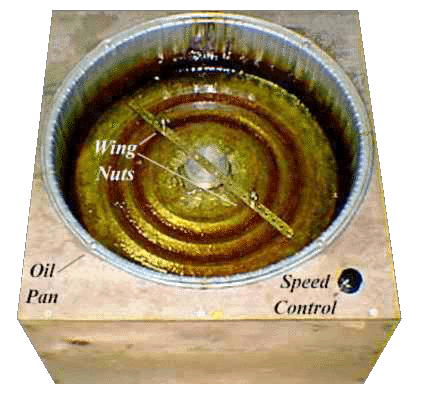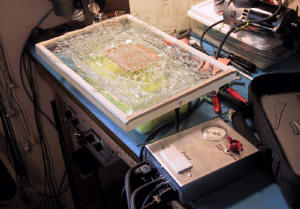|
Negative process PCB's |
|
|
|
|
| Photo-resist | Bill Photofabrication Chemical & Equipment Company 522 Route 30 Frazer, PA 19355 bus (610)296-8585 fax (610)993-8557 KPR resist #mp-111 ($95.00 per quart) Will sensitize about 200 sq feet of material |
| Developer | Photofabrication Chemical & Equipment Company KPR developer #mp-142/61 ($92.00 per gallon) Will develope about 4 quarts of KPR |
| KPR stripper | MEK (methyl ethyl ketone) From any hardware store About $12.00 per gallon |
| Copper cleaner | Comet cleanser and green Scotch-Bright pads From grocery store About $2.50 each for the giant family size |
| Hydrochloric acid solution | 5% solution in distilled water From chemical supply store About $12.00 per quart (Change tank once per 2 years) |
| Rubber gloves | A must when handling corrosives From grocery store (Playtex yellow recommended) About $2.00 pair |
|
Equipment |
|
|
|
|
|
Vacuum Exposure frame |
|
|
|
|
|
1. Wear the gloves to prevent contamination of the copper surface from body oils. 2. Use the Scotch-Bright pad and copper cleaner to shine up the surface to be imaged, there should be no oxidation remaining. 3. Rinse under HOT water to remove all cleaner. The hot water will help evaporate the MEK from the next step. Remove all water from surface. 4. Wipe surfaces to be imaged with MEK. There tends to be small amounts of oils in city delivered water which will prevent resist adhesion. (I usually skip this step) 5. Dip panel into HCL solution for 15 seconds being careful to prevent getting it on ANYTHING when you remove it. This step, more than any other, will determine the adhesion quality of the resist to the panel. KPR requires an acid PH, check with the manufaturer of your photo resist for PH requirements. 6. Rinse again under HOT water and wipe down with MEK. (Again, I usually skip the MEK wipe!) 7. Place panel in coater and pour small amount of KPR in center. Spin the panel fast for a few revolutions to coat the entire surface and then slow down to about 100 rpm to force off excess. You can stop the panel momentarily to verify coverage and add KPR as required, repeating this step. You must work under a red safe-light from this point forward. Be sure to lock the panel down securely because even at this low speed a spinning object in the work area can be very unpleasant. 8. Let the panel remain spinning until dry. You can let it dry unattended (About 30 minutes) or lightly heat to speed the drying process (About 2 minutes). A heat gun works better than a hair dryer but both work. 9. Give the panel a final dry with a heat gun or oven. When the panel has become unpleasantly hot to the touch it should be sufficiently dry. For large runs, an oven set to 75 degrees C will dry panels in about 10 minutes. Be sure to keep out of sunlight or fluorescent lights. Incandescent lighting (<60 watts) less than 2 minutes total can be tolerated. 10. Let the panel cool and then expose. A 300 watt halogen lamp at 9 inches for 1 minute will usually be sufficient. Use an exposure test sheet to be sure. Allow 1.25 minutes when exposing through Mylar. A vacuum exposure frame is a must for fine line work and the film emulsion must be in contact with the panel photo resist. The distance between the light source and the panel will determine the extent of the exposure error due to under-cutting of the light under the film. 11. It is best to develop KPR with a source of running COLD water, preferably a spray versus a stream outlet. Dip the panel into the developer for about 3 seconds and put directly under the spray. A fast spray will not harm the image and will accelerate the process. Keep under the spray until all solvent has been removed and repeat until the image is all that remains (About 3 cycles usually does it). I normally do this under incandescent lighting because the exposure is short and it's easier to see what you're doing. 12. After developed, forced hot air dry the panel and etch. KPR can be removed with MEK when done. |
|

